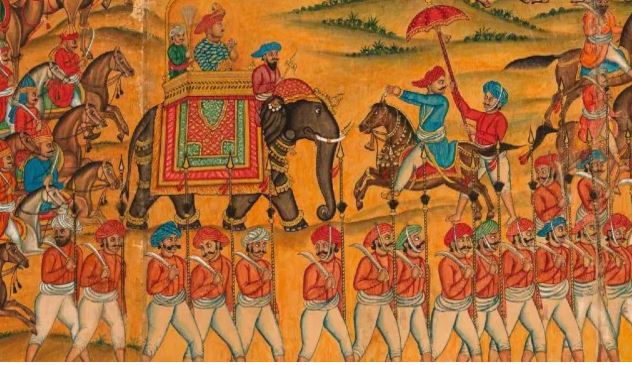A painting that showcases the erstwhile sultan of Mysore Haider Ali and his son, Tipu, riding into battle against the British troops of the East India Company has fetched about Rs 6.28 crore (£6,30,000) in an auction at Sotheby’s.
The painting titled ‘The Battle of Pollilur’ was part of the Sotheby’s “Arts of the Islamic World & India” auction on Wednesday.
The work described by historian William Dalrymple as “one of the great masterpieces of the period” in the catalogue note was among other exceptional artworks, manuscripts and paintings.
What does the painting depict?
The nearly 32-foot long painting depicts the victory of the Mysore army in the Battle of Pollilur, which took place on 7 September, 1780, as part of the Second Anglo-Mysore War. The painting shows British soldiers struggling against the Mysore army.
Dalrymple writes in a note on Sotheby’s website that the panorama, which presents “one of the crucial turning points of Indian history”, has been realised with “extraordinary vivacity and energy that has few rivals in the art of the period”.
Historian William Dalrymple writes in a note on Sotheby’s website that the panorama presents “one of the crucial turning points of Indian history”. Image courtesy: Sotheby’s
“The painting extends over ten large sheets of paper, nearly thirty-two feet (978.5 cm) long, and focuses in on the moment when the Company’s ammunition tumbril explodes, breaking the British square, while Tipu’s cavalry advances from left and right, ‘like waves of an angry sea’, according to the contemporary Mughal historian Ghulam Husain Khan. The pink-cheeked and rather effeminate-looking Company troops wait fearfully for the impact of the Mysore charge, as the gallant and thickly mustachioed Mysore lancers close in for the kill,” Dalrymple writes.
The left side of the painting shows Haider and Tipu looking on majestically and impassively at their triumph.
“Tipu, with magnificent sang-froid sniffs a single red rose as if on a pleasure outing to a garden to inspect his flowers.”
The painting titled ‘The Battle of Pollilur’ was part of the Sotheby’s “Arts of the Islamic World & India” auction on Wednesday. Image courtesy: Sotheby’s
On the other end of the painting, the Mysore army is shown attacking the Company forces on both sides as they form a square around an injured Scottish soldier named Colonel William Baillie sitting in a palanquin, who had led a column of four thousand Indian sepoys.
Why is the painting significant?
As a visual record of the battle, and to commemorate his victory, Tipu Sultan commissioned in 1784 the painting of the Battle of Pollilur as part of a large mural for the newly built Daria Daulat Bagh in Seringapatam, then the capital of Mysore.
According to a BBC report, some of the scenes on the monumental painting were also painted at least twice on paper using ink and gouache pigments.
One of those paintings was sold at a Sotheby’s auction in 2010 for £769,250 and was acquired by the Museum of Islamic Art in Qatar.
The painting was brought to England by Colonel John William Freese, who was in Srirangapatnam after Tipu’s defeat in 1799.
Freese’s family handed it down over generations before selling it to a private collector in 1978, who then sold it in 2010.
The work that was auctioned on Wednesday is part of a private collection in the UK, and has been displayed at several exhibitions in the past.(FP Explainers)

Readers like you, make ESHADOOT work possible. We need your support to deliver quality and positive news about India and Indian diaspora - and to keep it open for everyone. Your support is essential to continue our efforts. Every contribution, however big or small, is so valuable for our future.














